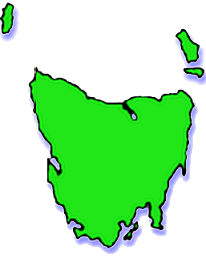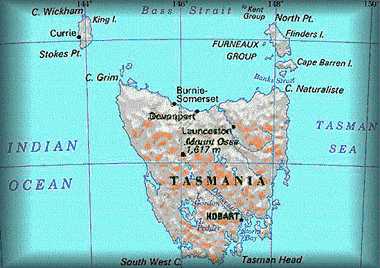

You are visitor number
 Statistics
Statistics
Population: 473,000
Hobart: 193,000
Launceston: 98,000
Burnie: 25,000
Devonport: 25,000
Location: 40°S,144°E
Area: 68,331 sq. km
Size: 315 km East-West
286 km North-South
Climate: Mild, maritime
climate with four distinct seasons. Average summer max. 21° C, average
winter max. 12° C with a minimum of 4° C. The rainfall varies from
620mm in Hobart, to 2400mm on the west coast, the rainfall is evenly spread
throughout the year.
General: The territory of Tasmania includes Bass Strait, King Island, Flinders Island, and the southern Macquarie Island, halfway between the Australian mainland and Antarctica. The combined area of Tasmania and it's smaller Islands is 68,331 sq. km or about 0.9% of the total area of Australia. Australia's deepest and longest caves and deepest natural freshwater lake (Lake St Clair) are found in Tasmania, as are some of the oldest and largest trees in the world. A Huon Pine in the south-west wilderness is estimated to be more than 4,000 years old, making it the oldest living thing on earth. Tasmania boasts some of the tallest and largest eucalypt trees in the world. Tasmania's Cascade Brewery is the country's oldest operating brewery; the Bush Inn at New Norfolk is the oldest continually licensed public house, and the Theatre Royal is the oldest operating live theatre. Northern Tasmania has the largest lavender farm in the world and is the only commercial lavender producer in the southern hemisphere. The fastest growing Atlantic salmon in the world are produced in Tasmania in some of the world's largest and most modern hatcheries. The cleanest air in the world is found in Tasmania on the north-west coast at Cape Grim and the rainwater is so pure it has been sent overseas for Australia's Olympic Games athletes and sold to expeditioners travelling to Antarctica! Tasmania is Australia's most decentralized state and Tasmanians travel the shortest distances of any other worker in the country between their home and work. Crime rates are also the lowest of the Australian states. Top
Tasmania offers a unique combination of wild and spectacular scenery and boundless opportunities for adventure. Whatever your age, fitness level, budget and tastes, Tasmania has scores of activities on offer - from easy 20 minute rain forest walks to strenuous week long expeditions, from gentle and sophisticated river cruises to explosive white water rafting action, from scrambles along rocky beaches to full scale mountaineering. Stand in a rain forest, cycle down the picturesque East Coast, stroll along a deserted beach, raft the beautiful Franklin River, saddle up and explore the high country trails, or just take in a roadside vista... the choice is yours. In Tasmania you will find as many ways to enjoy your holiday as there are hours in the day. And do take time to enjoy the incredible geographic and natural diversity, starting with the intact, unspoilt wilderness, maintaining 2000 year old native pines - one of the major reasons behind the listing of 20% of Tasmania as a World Heritage Area. Top
As an island, Tasmania is home to a wide range of sea life and offers magnificent scuba diving. Landlubbers can share in regular sightings close inshore of seals and dolphins, and if you're lucky, the occasional whale. Our flora is also unique, especially the delicate and tiny wild orchids that flower freely, in unobtrusively, from September to December. Multi coloured and dramatically shaped fungi are to be found throughout the forests, home to some of the tallest and oldest trees in the world. Tasmania is also rich in ancient and endemic forms of wildlife including an intriguing collection of larger predatory marsupials - the Tasmanian devil, the eastern and spotted quolls and possibly, still, the Tasmanian tiger. As well, the island is home to two curious egg laying monotremes - the platypus and echidna, plus more than 300 species of birds and many other fascinating and rare creatures in the world of lizards, shrimps and worms. Outdoor adventure is as easy or as challenging as you wish to make it. Friendly and professional tour operators can guide you safely through the complete spectrum of activities - or you can do it all yourself. Top
Adding to Your Experience: You will greatly enhance your adventure if you learn something of the history, flora and fauna of an area before you venture forth, and do look out for Nature Trails located in our National Parks and Forest Reserves. They are a fine introduction to the plants and wildlife. Visitor Centres are also excellent for local information.. Their first class displays include social as well as natural history. Park Rangers readily share their knowledge and often organize special educational tours including evening forays to meet the nocturnal animals. Books, track notes and field guides are recommended for certain activities.
Talk to the Locals: Tasmanians are a friendly, hospitable lot and have a wealth of information you won't get anywhere else - track conditions, history, fishing techniques: simply ask.
Guided Tours: Whatever your choice of activity, a guided tour can take you straight to the heart of the experience. Operators can provide appropriate equipment and background information and the guides are experts in their field; outdoor people with a wide knowledge of their environment.
Plan Ahead: Tasmanian Travel Centre staff will be happy to discuss your travel plans to ensure that you get the best from your Tasmanian holiday. Top
Keeping Tasmania Natural: There are very few wild places left in the world. Only responsible travel can conserve these setting for future generations to enjoy. Low impact travel means leaving little or no trace of your presence. To ensure the survival of our wild areas it is vital that we all care for and respect them. Walking and camping should have a minimal impact on the environment. Here are some of the basics for low impact travelling:
Go to Tasmania Online,
for a complete lising of all interesting sites about this beautiful island.
This page was created by me, Justin
Austbo of Ulverstone, Tasmania, as part of my Year 10 Information Technology
course titled 'Information Management'. It was produced using both
the resources available to me at my school Ulverstone High - Apple Macintosh
LC 475's running Adobe® PageMill™, ClarisWorks™ Office, OneScan®
Dispatcher™, Graphic Converter, and when disaster struck - Simple Text
for HTML scripting, and also my own PC, a 486DX4/100 running Internet Explorer
3.0, Netscape® Communicator 4.05, ClarisWorks™ Office 4.0, Paint Shop
Pro 5.0, and sometimes even the ever reliable NotePad.
Special thanks to my mother Pauline,
for the typing of over 30 10pt. pages, to my IT teacher Noel Hortle, for
his patience and kindness in giving me yet another extension, and to the
Tasmanian
Department of Tourism, Sport and Recreation, and the Department
of Parks, Wildlife and Heritage for their fantastic brochure's and
reference articles.
Contact the Spirit
of Tasmania (TT-Line) for information regarding travel to and from
Tasmania.
And visit the Thrifty
Car Rental page, to reserve your car online now!!
Any comments? e-mail me at jaustbo@hotmail.com


